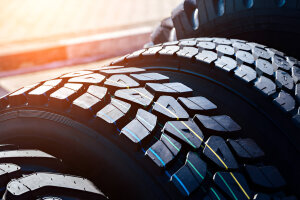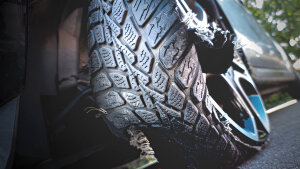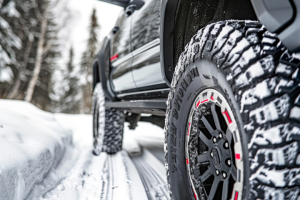Last Updated on August 28, 2024
Boosting Truck Efficiency: Pairing New Tires with New Wheels
Welcome to “Tire Easy Truck,” where we focus on ensuring your truck is always ready to hit the road confidently. This article is essential for truck owners, operators, and enthusiasts. Here, we will explain the crucial aspects of truck maintenance, emphasizing tires and wheels – two components that play a pivotal role in your truck’s performance, safety, and efficiency.
Maximizing Truck Performance and Safety
This blog post aims to educate and inform truck owners and enthusiasts about the importance of tires and wheels in their vehicles. It aims to:
- Highlight the Key Roles of Tires and Wheels: Understanding the functions of these components can help truck owners make informed decisions about maintenance and replacements.
- Guide in Maintenance and Replacement Decisions: This post provides valuable insights into when and why you might need to consider replacing your tires and wheels, what to look for in new products, and how to maintain them for optimal performance and safety.
- Enhance Safety and Performance: By emphasizing the importance of quality tires and wheels, we want to contribute to the safety and efficiency of trucks on the road.
- Encourage Informed Purchasing: With various available options, we can help you choose the right tires and wheels for your truck based on its specific needs and your personal preferences.
The tires and wheels of your truck are fundamental components that require careful consideration and regular maintenance. This blog post is a step towards empowering you with the knowledge necessary to ensure your vehicle is always road-ready, safe, and efficient.
Overview of Tire and Wheel Importance in Trucks
Tires and wheels are more than just the parts of your truck that touch the road. They are the foundation of your truck’s performance. Here’s why they are essential:
- Safety First: Tires and wheels are designed to provide a safe and stable connection between your truck and the road. They are also designed to handle heavy loads, resist wear and tear, and provide traction in various weather conditions. A good set of tires and wheels can significantly reduce the risk of accidents, especially in challenging driving conditions.
- Performance and Efficiency: Your truck’s tires and wheels directly influence its handling, acceleration, braking, and fuel efficiency. The correct tire and wheel combination can enhance your truck’s ability to navigate different terrains and conditions while contributing to smoother and more efficient operation.
- Load Carrying Capability: Trucks are often used for transporting heavy loads. The tires and wheels must be robust enough to support these loads without compromising safety or performance. They need to withstand the pressure and stress of heavy cargo, ensuring that your truck can perform its duties reliably.
- Durability and Longevity: The longevity of your truck’s tires and wheels is necessary for minimizing downtime and maintenance costs. Durable tires and wheels can withstand the rigors of frequent use, harsh environments, and long-distance travel, making them a long-term investment in your truck’s functionality.
Understanding Tires and Wheels
Tires and wheels are of the utmost importance for keeping trucks in good shape and functioning. These are essential parts that directly affect how efficiently your truck works.
By understanding tires and wheels comprehensively, truck owners and operators can ensure their vehicles are roadworthy and optimized for peak performance.
Basic Anatomy of Truck Tires and Wheels
Truck tires and wheels are sophisticated components engineered to meet specific performance demands. Understanding their basic anatomy is required for proper maintenance and ensuring your truck performs at its best.
Tire Components
Tires are intricate structures specifically designed to offer traction, bear the vehicle’s weight, and absorb any shocks that may arise from the road. Here is an overview of the main components that make up a tire:
- Tread: This is the outermost layer that makes contact with the road. It’s designed with specific patterns and depths to provide traction and channel water away in wet conditions.
- Sidewalls: These are the sides of the tire. They are vital for lateral stability and protecting the tire’s internal components.
- Beads: The beads secure the tire to the wheel rim. They are made of high-strength steel coated in rubber, ensuring a tight fit.
- Carcass: This is the tire’s body beneath the tread. It is usually made of layers of fabric-like material called plies, which give the tire strength and flexibility.
- Belts: These steel layers sit between the carcass and the tread, providing stability, strength, and puncture resistance.
Wheel Components
The wheel plays a huge role in connecting the tire to a vehicle’s suspension system. Here are the essential components of a wheel:
- Rim: This is the outer circular design of the wheel on which the tire is mounted. It supports the tire’s carcass on both sides.
- Hub: This is the central part of the wheel, housing the bearings and providing a mounting point for the wheel and braking systems.
- Spokes: Some truck wheels have spokes, which connect the rim to the hub, contributing to the wheel’s strength and style.
- Valve Stem: This is a small protrusion through which air is added to or released from the tire.
The Role of Tires and Wheels in Truck Performance
The performance of a truck is closely connected to the quality and features of its tires and wheels. Here’s the role they both play:
- Traction and Handling: Tires have a tread pattern that maximizes contact with the road to give the grip required for maneuvering and braking. Large trucks require good traction to maneuver, especially when carrying heavy loads or in inclement weather.
- Load Bearing: Trucks are designed to carry heavy loads, and the tires and wheels must be able to support this weight. The wheel’s strength and the tire’s sidewall rigidity are essential for carrying heavy loads without compromising the vehicle’s stability and safety.
- Fuel Efficiency: Tire rolling resistance impacts fuel efficiency. Properly inflated tires with an optimized tread design can reduce the energy required to move the truck, improving fuel efficiency.
- Ride Comfort: The design of tires and wheels also impacts the ride’s comfort. Properly designed and maintained tires reduce vibrations, which is particularly important in long-haul trucks to reduce driver fatigue.
- Safety: Tires with adequate tread depth and properly maintained wheels are essential for safety. They reduce the risk of accidents caused by tire blowouts or loss of control, especially when carrying heavy loads or driving at high speeds.
When to Consider New Tires?
Timely tire replacement ensures your safety on the road and contributes to your vehicle’s optimal functioning and longevity. We will explore the key indicators and considerations that signal the need for new tires.
Signs of Tire Wear and Tear
Recognizing the signs of wear and tear helps determine when it’s time to replace tires. Other warning signs that you should be aware of include:
- Tread Depth: Reduced tread depth is the most apparent sign of tire wear. For truck tires, a tread depth of less than 4/32 inch indicates it’s time for a replacement. The penny test is simple: insert a penny into the tread groove with Lincoln’s head facing down. Your tread is too shallow if you can see the top of Lincoln’s head.
- Uneven Wear Patterns: Uneven wear can indicate alignment issues, improper inflation, or suspension problems. Look for areas on the tire where the tread is more worn than on other parts.
- Sidewall Damage: Check the sidewalls for cracks, cuts, or bulges. Damage here can indicate structural problems that may lead to tire failure.
- Vibration or Unusual Noises: Excessive driving vibration or noise could suggest internal tire damage or misalignment.
- Age of the Tires: Even if the tread is not significantly worn down, tires degrade over time. Most manufacturers recommend replacing truck tires every 5-6 years, regardless of the mileage.
Impact of Worn Tires on Truck Safety and Efficiency
Worn tires can significantly impact a truck’s safety and efficiency, making it imperative to replace them when necessary. Some of these impacts are:
- Reduced Traction and Handling: Worn tires significantly reduce traction, which is necessary for safe handling and braking, especially in adverse weather conditions. This can lead to longer stopping distances and increased risk of skidding.
- Increased Risk of Blowouts: Worn or damaged tires are more susceptible to blowouts, which can be particularly dangerous for heavy trucks at high speeds or in heavy traffic.
- Compromised Load Bearing: Trucks rely on their tires to support heavy loads. Worn tires may not be able to safely bear the truck’s load, leading to instability and potential accidents.
- Decreased Fuel Efficiency: Worn tires can increase rolling resistance, which requires more energy (fuel) to move and maintain the truck’s speed. This leads to decreased fuel efficiency, increasing operational costs.
- Impact on Suspension and Alignment: Continuously driving on worn tires can strain the truck’s suspension and alignment systems, leading to more extensive and expensive repairs.
Being proactive in replacing worn tires ensures your truck operates safely, contributes to its longevity, and reduces the total cost of ownership.
Evaluating Your Wheels
Paying attention to the condition of your wheels is just as important as caring for your tires. Proper wheel evaluation is essential for maintenance and ensuring your vehicle’s safety, efficiency, and longevity.
Assessing Wheel Condition
Regularly assessing wheel condition as part of routine maintenance contributes to a safe and efficient driving experience. Here’s how to assess their condition:
- Visual Inspection: Begin by visually checking the wheel surface for cracks, bends, or significant rust. Damage or deformities can compromise the wheel’s integrity.
- Check for Alignment Issues: Wheels out of alignment can cause uneven tire wear and affect the truck’s handling. Look for signs of uneven wear on the tires, which might suggest an alignment problem with the wheels.
- Inspect Lug Nuts and Bolts: Ensure all lug nuts and bolts are intact, tight, and not corroded. Loose or damaged lug nuts can make wheels unstable or even detach.
- Look for Signs of Corrosion: Check for corrosion, which can weaken the wheel structure over time, especially in metal wheels.
- Assess Wheel Balance: A wheel imbalance can cause vibrations and uneven tire wear. If you notice vibrations at certain speeds, it might indicate that the wheels need balancing.
If you notice any abnormalities or have concerns about the wheels, consult a qualified mechanic or professional for a thorough inspection and necessary repairs.
The Relationship Between Tire Wear and Wheel Damage
The relationship between tires and wheels is a reciprocal one; the condition of one can significantly affect the other in the following ways:
- Impact of Wheel Damage on Tires: Damaged or misaligned wheels can cause uneven tire wear. For example, a bent wheel rim can lead to irregular tire wear patterns, reducing the tire’s lifespan.
- Wheel Imbalance and Tire Stress: An imbalanced wheel causes the tire to rotate unevenly, putting additional stress on certain parts of the tire. This leads to premature tire wear and can impact fuel efficiency and ride comfort.
- Effect of Wheel Condition on Tire Pressure: Damaged or corroded wheels can impact tire pressure. For instance, a corroded wheel rim might not seal properly, leading to slow air leaks in tires.
- Vibration Transmission: Wheels in poor condition can transmit excessive vibrations to the tires, which can accelerate tire wear and potentially cause structural damage to the tire.
The Interplay Between Tires and Wheels
The relationship between tires and wheels plays a significant role in ensuring your truck performs at its best. Let’s explore how these two components work together and the advantages of coordinating new tires with wheels.
How Tires and Wheels Work Together
As a truck owner, making sure that your tires and wheels work together can help you in the following ways:
- Structural Harmony: The tire and the wheel must fit together perfectly. The right match ensures the tire maintains proper inflation and performs correctly. A mismatch can lead to tire damage, air loss, and even tire failure.
- Load Distribution: Both tires and wheels are designed to handle specific load capacities. When paired correctly, they evenly distribute the truck’s weight and any additional load, which is vital for stability and safety, especially when transporting heavy cargo.
- Handling and Maneuverability: The interaction between tire tread and wheel design affects the truck’s handling. Properly matched tires and wheels improve traction, braking, and cornering abilities, contributing to safer and more responsive driving.
- Vibration Reduction: A well-matched tire and wheel setup can minimize vibrations, leading to a smoother ride. This is particularly important in long-haul trucks to reduce driver fatigue.
Benefits of Matching New Tires with New Wheels
Matching new tires with new wheels offers several benefits in aesthetics and driving experience. Here are some of the benefits you can expect:
- Optimized Performance: When matched correctly, new tires and wheels provide optimal performance. This combination ensures that both components are in prime condition, offering the best traction, handling, and fuel efficiency.
- Enhanced Safety: New wheels with new tires reduce the risk of blowouts, punctures, and other tire-related failures. This is especially necessary for trucks, which often operate under demanding conditions.
- Longevity and Durability: When both tires and wheels are new, they wear down together more uniformly. This harmonized wear can extend the overall lifespan of both components.
- Improved Aesthetics: New tires and wheels can significantly enhance the visual appeal of your truck. This not only makes your vehicle look better but can also contribute to a higher resale value.
- Cost-Efficiency in the Long Run: Investing in new tires and wheels simultaneously can be more cost-effective over time. It eliminates the need for frequent adjustments and alignments that arise from mismatched or worn-out components.
Factors to Consider Before Buying New Wheels
When you invest in new wheels for your truck, you’ll notice a significant improvement in your driving experience. Before you decide, you should consider a few factors to help ensure that the new wheels meet your requirements and are compatible with your vehicle.
Cost-Benefit Analysis
A cost-benefit analysis thoroughly examines the expected benefits of buying new wheels and the costs involved. It provides valuable information to help you make informed decisions. Let’s look at why conducting a cost-benefit analysis is essential when buying new wheels:
- Initial Investment vs. Long-Term Value: Assess the upfront cost of new wheels against their potential to improve fuel efficiency, safety, and performance. Higher-quality wheels may have a more significant initial cost but can offer better value over time through durability and reduced need for replacements.
- Maintenance Costs: Consider the maintenance requirements of different wheel types. Steel wheels might be less expensive but require more upkeep than alloy wheels.
- Impact on Resale Value: Quality wheels can enhance the resale value of your truck. It’s worth considering if the investment in new wheels will pay off when selling your vehicle.
Wheel Compatibility with Different Truck Models
Wheel compatibility is a significant consideration for truck owners and enthusiasts who want to customize or replace their wheels. The correct set of wheels impacts its maneuverability, off-road performance, and overall driving satisfaction. Here are some things to consider if you want to change your wheels:
- Size and Fit: Ensure the wheels are the correct size for your truck model. Using too large or too small wheels can affect the vehicle’s handling, stability, and safety.
- Load Rating: The wheels must be capable of supporting the weight of your truck and its typical load. This is especially important for trucks used in commercial operations or for towing.
- Bolt Pattern: The new wheels should match the bolt pattern of your truck. An incorrect bolt pattern can lead to improper wheel alignment and potential safety risks.
Aesthetic and Performance Considerations
When you’re thinking about getting new wheels for your vehicle, there are two main things to remember: aesthetics and performance. Finding the perfect balance between these two is fundamental in the following ways:
- Design and Style: Wheels significantly influence your truck’s appearance. Choose a style that complements your truck’s design and reflects your taste.
- Material and Construction: The material of the wheels (alloy, steel, etc.) affects their weight, which in turn impacts performance. Lighter wheels can enhance acceleration and fuel efficiency but might be less durable than heavier options.
- Performance Benefits: Consider how different wheel types can enhance your truck’s performance. For example, some wheels are designed for better heat dissipation, benefiting trucks that frequently carry heavy loads or travel long distances.
Buying new wheels for your truck is a decision that should be made carefully, considering various factors, including cost, compatibility, aesthetics, and performance. By assessing these factors, you can ensure that your choice enhances the look of your truck and contributes positively to its overall functionality and value.
Advantages of Buying New Wheels with Tires
Buying new wheels and tires simultaneously can bring many benefits for truck owners. Let’s explore the key advantages of investing in both new wheels and tires:
Enhanced Safety and Performance
- Optimal Fit and Compatibility: Buying new wheels and tires together ensures they are compatible in size, load capacity, and design. This compatibility is required to maintain the truck’s stability and handling, especially under heavy loads or challenging driving conditions.
- Improved Traction and Handling: When matched with new wheels, new tires provide better traction and handling. This is particularly important for trucks, where superior grip and control are essential for safety.
- Reduced Risk of Tire Failure: New wheels can enhance the structural integrity of the tire setup, reducing the risk of tire failures such as blowouts, which are often attributed to worn or damaged wheels.
Long-term Cost Savings
- Extended Tire Life: When tires are mounted on new wheels, they wear more evenly, extending their lifespan. This can lead to fewer tire replacements, offering long-term cost savings.
- Improved Fuel Efficiency: New tire and wheel combinations can be optimized for better fuel efficiency. The proper setup can reduce rolling resistance, leading to significant fuel savings, especially in long-haul trucks.
- Reduced Maintenance Costs: With new wheels and tires, the likelihood of encountering common wheel-related problems (such as alignment issues) is lower, which can reduce maintenance costs over time.
Improved Aesthetics and Resale Value
- Enhanced Visual Appeal: New wheels and tires can dramatically improve the aesthetic appeal of a truck. The right combination can give your vehicle a more modern, refreshed look.
- Increased Resale Value: Trucks with new wheels and tires often command a higher resale value. This is due to the perceived value of new components and the visual appeal they add to the vehicle.
- Customization Options: Purchasing new wheels and tires allows you to customize your truck better to suit your style or specific performance needs.
Investing in new wheels and tires simultaneously offers numerous advantages, from enhanced safety and performance to long-term cost savings and improved aesthetics. This decision impacts the immediate functionality of the truck and contributes to its overall value and appeal. This is an investment worth considering for truck owners.
Case Studies
Upgrading to new wheels is not just a matter of aesthetics; it can have significant implications for trucks’ performance, safety, and efficiency. This section presents real-life case studies and expert insights, illustrating the tangible benefits of investing in new wheels for trucks.
Real-Life Scenarios Where New Wheels Were Beneficial
These real-life examples demonstrate how upgrading to new wheels can provide various benefits that meet specific driving needs and preferences:
- Improved Fuel Efficiency: In a case involving a fleet of long-haul trucks, replacing old wheels with newer, lighter alloy models resulted in a noticeable improvement in fuel efficiency. The reduced weight of the alloy wheels decreased the overall load, reducing fuel consumption.
- Enhanced Safety in Harsh Conditions: A truck operating in a region with harsh weather conditions experienced frequent tire-related incidents. After switching to new, high-quality wheels designed for such situations, tire failures markedly decreased, enhancing the safety of the vehicle and its cargo.
- Increased Load Capacity: For a commercial truck used in construction, upgrading to more substantial, more robust wheels allowed for an increase in load capacity without compromising the vehicle’s stability or performance.
- Extended Tire Life: A case study involving a logistics company showed that after upgrading to new wheels, the tires’ lifespan increased significantly. The new wheels provided better support and reduced uneven wear, leading to longer intervals between tire replacements.
Expert Opinions and Recommendations
Let’s explore the valuable insights shared by automotive experts on changing wheels and tires:
- Importance of Wheel Quality: Experts emphasize the importance of choosing high-quality wheels, as they play a significant role in the truck’s overall performance and safety. They recommend selecting wheels designed for the truck’s intended use and load requirements.
- Compatibility and Size: Professionals in the field advise that when selecting new wheels, it’s essential to ensure they are compatible with the truck model and tire size. Incorrect sizing can lead to safety issues and decreased performance.
- Benefits of Regular Maintenance: Experts also highlight the importance of regular wheel maintenance, including checks for alignment, damage, and wear. Proper maintenance can extend the life of both the wheels and tires.
- Investment in Safety: Safety is a recurring theme in expert recommendations. Investing in high-quality wheels is viewed as a financial decision and a commitment to safety and reliability.
These case studies and expert opinions underscore the significant advantages of investing in new truck wheels. For truck owners and operators, understanding these real-life scenarios and expert recommendations can be invaluable in understanding wheel upgrades.
Maintaining Your Tires and Wheels
Regular maintenance of your tires and wheels will extend their lifespan, ensure they work at their best, and give you a safe, smooth ride. We’ll explore some of the best ways to keep your tires and wheels healthy and ensure they last as long as possible.
Best Practices for Tire and Wheel Maintenance
Your truck’s tires and wheels are at the core of the meeting point between safety and performance on the road. If you neglect to maintain them, your driving safety can be at risk. Here are the best practices you can incorporate into your routine:
- Regular Inspections: Conduct frequent visual inspections of both tires and wheels. Look for signs of wear, damage, or irregularities. This includes checking for cuts, cracks, tire bulges, and any wheel corrosion or damage signs.
- Maintain Proper Tire Pressure: Always keep the tires inflated to the manufacturer’s recommended levels. Underinflation can lead to increased wear and tear, while overinflation can cause blowouts. Regularly check tire pressure, especially before long trips.
- Balancing and Alignment: Have your wheels balanced and aligned periodically. This prevents uneven wear on tires and ensures that your truck handles appropriately. Wheel alignment should be checked whenever you get new tires or notice erratic wear patterns.
- Rotate Tires Regularly: Tire rotation is essential for ensuring even tire wear. Follow the manufacturer’s recommendations or rotate tires every 6,000 to 8,000 miles. This practice helps in extending the overall life of your tires.
- Clean Tires and Wheels: Regular cleaning helps identify issues that may not be immediately visible under dirt and grime. It also prevents wheel rust and corrosion and keeps the tire treads clear of debris.
- Avoid Overloading: Overloading your truck puts additional stress on both tires and wheels, leading to wear faster. Always adhere to the load capacity ratings specified for your tires and vehicle.
Tips for Extending the Lifespan of Tires and Wheels
Increasing the longevity of your tires and wheels is a wise financial decision. It plays a vital role in ensuring a safe and enjoyable driving experience. Here are some helpful tips for extending the life of your tires and wheels:
- Use Quality Products: Invest in high-quality tires and wheels suitable for your truck’s needs. Quality products tend to have a longer lifespan and offer better performance.
- Drive Carefully: Avoid habits like aggressive driving, sudden braking, and fast turns, which can put undue stress on your tires and wheels.
- Monitor for Environmental Damage: Be mindful of environmental factors like extreme temperatures, exposure to sunlight, and contact with chemicals or oils, all of which can affect the longevity of tires and wheels.
- Store Properly: If you have a set of tires or wheels that are not in use, store them in a cool, dry place away from direct sunlight and heat sources. This helps in preventing premature aging of rubber and corrosion of metal.
- Seek Professional Help: For any maintenance activities you are uncomfortable performing yourself, such as wheel alignment, always seek assistance from a professional.
By following these best practices and tips, you can enhance the safety and efficiency of your vehicle and save on long-term costs associated with tire and wheel replacements.
Conclusion & Recommendations
As we conclude our comprehensive guide, we must revisit the key insights and recommendations for truck owners. The journey through understanding the roles of tires and wheels, recognizing when replacements are necessary, appreciating the interplay between these components, and acknowledging the importance of regular maintenance will equip you with the knowledge to make informed decisions for your truck.
Recap of Key Points
We explained the anatomy of truck tires and wheels, highlighting how their design contributes to overall truck performance. We examined the signs indicating the need for new tires and the impact of worn tires on safety and efficiency, emphasizing the importance of timely replacements. We also explored the relationship between tire wear and wheel damage, underlining the need for regular assessments.
The advantages of synchronizing the purchase of new wheels with tires were discussed, showcasing how this can enhance safety, performance, and aesthetics. Additionally, the factors to consider before buying new wheels, including cost-benefit analysis, compatibility, and aesthetic choices, were detailed to assist in making a sound investment.
Final Recommendations for Truck Owners
As a truck owner, regular inspections and maintenance of tires and wheels should be a top priority. Opt for high-quality, compatible tires and wheels that suit your truck’s needs and driving conditions.
Be proactive in replacing tires and wheels when needed, and don’t hesitate to consult professionals for advice and services like wheel alignment and balancing. This investment is not just in the parts themselves but in the assurance of a smoother, safer journey every time you hit the road.
Why Tire Easy Truck
Understanding the intricacies of tires and wheels for your truck can be challenging, but it doesn’t have to be. At Tire Easy Truck, we simplify this process for you. Our extensive selection of tires and wheels is designed to meet the diverse needs of truck owners, offering quality, reliability, and performance. Whether you’re looking for durability for long hauls, stability for heavy loads, or an upgrade for better efficiency and aesthetics, we have you covered.
Take the guesswork out of your next tire and wheel purchase. Trust Tire Easy Truck to provide you with products that ensure your truck is always ready for the journey ahead. Click below to explore our range and find the perfect match for your car today.
Explore Tires and Wheels at Tire Easy Truck
FAQs
Does changing wheels affect performance?
Yes, changing wheels can significantly affect a truck’s performance. New wheels can improve handling, fuel efficiency, and safety. The type of wheel chosen can also affect the truck’s ride quality and ability to handle different terrain.
What is the importance of a wheel in a truck?
Wheels are essential for a truck as they directly impact its handling, stability, and safety. They play a crucial role in bearing the vehicle’s weight, which is especially important for trucks that carry heavy loads and ensure a smooth connection with the road.
Why would you need new wheels?
You need new wheels if the existing ones are damaged, worn out, or no longer provide optimal performance. Upgrading wheels can also be a consideration for aesthetic reasons or to improve vehicle handling and fuel efficiency.
Why should I consider buying new wheels with new tires?
Buying new wheels with your new tires can enhance overall vehicle performance, ensure compatibility, and improve safety. It also provides that both components are in optimal condition for the road.
How do new wheels benefit the performance of my truck?
New wheels, especially when matched with new tires, can improve handling, increase fuel efficiency, and ensure better vehicle stability.
Are there cost benefits to buying wheels and tires together?
Purchasing wheels and tires together can be cost-effective in the long run, reducing maintenance costs and extending the lifespan.
Can I replace my tires and keep my old wheels?
Yes, you can replace just the tires. However, if your wheels are old or damaged, they can negatively impact the new tires’ performance and longevity.
How do I know if my wheels need replacing?
Signs that your wheels may need replacing include visible damage, such as cracks or bends, corrosion, and tire fitting or air retention issues.
Will new wheels improve the resale value of my truck?
New wheels can improve your truck’s aesthetic appeal, potentially increasing its resale value.
Do all new tires require new wheels?
Not necessarily, but it’s essential to assess the condition of your wheels when getting new tires. Replacement is recommended if the wheels are damaged or incompatible with the new tires.
Where can I get advice on the best wheels to pair with my new tires?
Consulting with tire and wheel professionals, like those at Tire Easy Truck, can provide tailored advice based on your truck’s model and driving needs.











 English
English Français
Français Español
Español